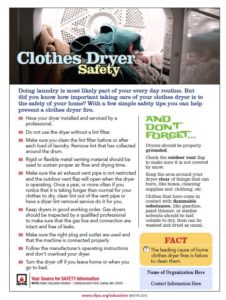
Clothes Dryers a Common Spark for House Fires
Doing the laundry could be hazardous to your health.
That’s because laundry equipment often provides the spark for house fires that destroy houses and lives, according to the National Fire Prevention Association.
In 2010, an estimated 16,800 reported U.S. home structure fires involving clothes dryers or washing machines (including combination washer/dryers) resulted in 51 civilian deaths, 380 civilian injuries, and $236 million in direct property damage, the NFPA reported.
The leading cause of home clothes dryer and washer fires is failure to clean them. So here’s what the NFPA recommends:
- Have your dryer installed and serviced by a professional.
- Do not use the dryer without a lint filter.
- Make sure you clean the lint filter before or after each load of laundry. Remove lint that has collected around the drum.
- Rigid or flexible metal venting material should be used to sustain proper air flow and drying time.
- Make sure the air exhaust vent pipe is not restricted and the outdoor vent flap will open when the dryer is operating. Once a year, or more often if you notice that it is taking longer than normal for your clothes to dry, clean lint out of the vent pipe or have a dryer lint removal service do it for you.
- Keep dryers in good working order. Gas dryers should be inspected by a professional to make sure that the gas line and connection are intact and free of leaks.
-
Make sure the right plug and outlet are used and that the machine is connected properly.
- Follow the manufacturer’s operating instructions and don’t overload your dryer.
- Turn the dryer off if you leave home or when you go to bed.
Here’s a PDF listing these tips that you can download, print, read, AND give or forward to family and friends:

Home Grills a Source of Good Cheer but Also Grief
Backyard grilling is supposed to be about food, fun, family and friends.
All too often, it’s also about house fires.
Each year, an average of 8,900 house fires are caused by grilling, and close to half of all injuries involving grills are due to thermal burns, according to the nonprofit National Fire Prevention Association. While nearly half of the people who grill do it year-round, July is the peak month for grill fires, followed by May, June and August, the NFPA reports.
Here’s more data from the NFPA on fires caused by backyard grilling:
- In 2014, 16,600 patients went to emergency rooms because of injuries involving grills
- Failure to clean the grill was the leading factor contributing to the fire in 19 percent of all grill structure fires. In 17%, something that could catch fire was too close to the grill
- Leaks or breaks were factors in 11% of grill structure fires and 23% of outside and unclassified grill fires
- Gas grills contribute to a higher number of home fires overall than their charcoal counterparts